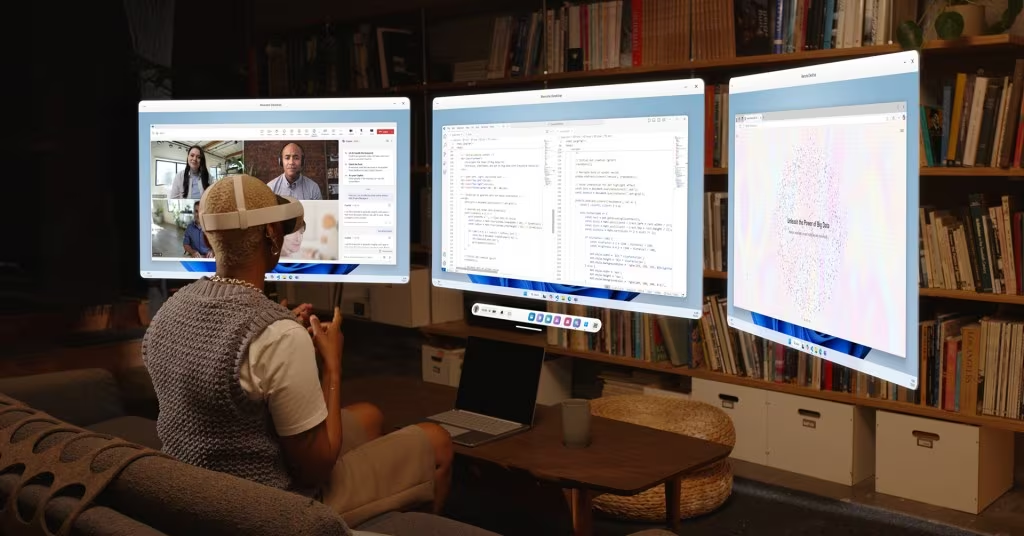Microsoft Brings Vision Pro-Level Virtual Desktops to Meta Quest 3
In a significant move cementing mixed reality (MR) headsets as serious productivity tools, Microsoft has announced the wide availability of its high-fidelity remote desktop feature for the Meta Quest 3 and Quest 3S headsets. This functionality allows users to stream their full Windows 11 desktop environment directly into the virtual space, offering a seamless, high-resolution experience comparable to the virtual desktop capabilities seen on the much higher-priced Apple Vision Pro.
This feature, often referred to as the Windows Mixed Reality Link or similar dedicated remote desktop protocol (RDP) integration, transforms the Quest headset from a gaming and social device into a powerful remote workstation. Users can now access their entire PC setup—including demanding applications and complex workflows—while viewing multiple virtual monitors or a single expansive ultrawide screen, all rendered with exceptional clarity within the headset’s passthrough environment.
Technical Deep Dive: The Virtual Monitor Environment
The core of this update lies in the ability to render virtual screens with the necessary fidelity and low latency required for professional work. Unlike earlier, lower-resolution screen mirroring tools, this new integration leverages the advanced capabilities of the Quest 3’s hardware, particularly its improved passthrough and display resolution, to deliver a truly usable workspace.
Key Functionality and Configuration
This new Windows 11 remote desktop experience offers critical flexibility for power users:
- Multiple High-Resolution Monitors: Users can configure and arrange several virtual monitors around them in 3D space. This is essential for multitasking, coding, design, and data analysis, where simultaneous viewing of multiple windows is mandatory.
- Ultrawide Display Option: For tasks requiring maximum horizontal screen real estate, such as video editing timelines or complex spreadsheets, the system supports a single, expansive ultrawide virtual display.
- Passthrough Integration: Because the Quest 3 utilizes color passthrough, users can place these virtual Windows screens seamlessly within their real-world environment. They can see their physical keyboard, desk, and colleagues while interacting with their virtual monitors, blurring the line between the physical and digital workspace.

Requirements and Availability
While the specific application name may vary (often integrated via Windows 365 or a dedicated Meta/Microsoft application), the requirement remains consistent: a host PC running Windows 11 and a Meta Quest 3 or Quest 3S headset. The wide rollout signifies that this feature is stable, optimized, and ready for mass adoption, moving beyond the limited beta testing phases that characterized its initial release.
“The widespread availability of high-fidelity remote desktop access is a pivotal moment for the Quest platform, validating its potential as a true competitor in the enterprise and productivity space against premium offerings,” stated a technology analyst familiar with the VR market.
The Productivity Paradigm Shift and Competitive Landscape
Microsoft’s decision to prioritize the Quest platform for this high-end remote desktop functionality has significant implications for the burgeoning mixed reality productivity market.
Direct Comparison to Apple Vision Pro
For months, the Apple Vision Pro has been lauded for its seamless integration of the macOS desktop into the headset environment, offering unparalleled clarity and stability for virtual work. However, the Vision Pro carries a premium price point, limiting its accessibility.
By bringing a comparable, high-fidelity Windows 11 experience to the significantly more affordable Meta Quest 3, Microsoft and Meta are democratizing the virtual workspace. This move directly challenges the notion that high-end, productive mixed reality is exclusive to the most expensive hardware.
| Feature | Meta Quest 3 (with Windows Link) | Apple Vision Pro (with Mac Integration) |
|---|---|---|
| Host OS | Windows 11 | macOS |
| Virtual Monitors | Multiple high-res or Ultrawide | Single large display (Mac) + Native Apps |
| Passthrough | Color Passthrough | High-Fidelity Passthrough |
| Primary Use Case | Remote PC Access, Multitasking | Native Apps, Mac Mirroring |
| Price Point | Accessible Consumer/Prosumer | Premium/High-End |

Implications for Remote Work
The ability to instantly set up a multi-monitor workstation anywhere—whether on a train, in a coffee shop, or in a small apartment—solves a critical pain point for remote workers and digital nomads. This feature eliminates the physical constraints of screen size and desk space, offering an infinite canvas for work.
Furthermore, the integration is crucial for organizations that rely heavily on the Windows 365 Cloud PC service. Employees can now securely access their cloud-hosted desktops, maintaining corporate security standards while benefiting from the immersive, multi-screen VR environment.
Key Takeaways for Users and the Industry
This wide release marks a major milestone in the evolution of consumer VR hardware into professional productivity tools. For users, the benefits are immediate and substantial:
- High-Fidelity Access: Users gain access to a stable, high-resolution remote desktop experience suitable for professional tasks.
- Multi-Screen Freedom: The limitation of physical screen space is removed, allowing for the creation of complex, multi-monitor virtual setups.
- Cost-Effective Productivity: The Quest 3, being significantly less expensive than competing high-end MR headsets, now offers a compelling value proposition for virtual desktop use.
- Seamless Windows Integration: The feature ensures deep compatibility with the Windows 11 ecosystem, including peripherals and software.
This development underscores the intensifying competition between Meta and Apple in the mixed reality space, with Microsoft acting as a crucial enabler on the Quest platform, ensuring that the dominant PC operating system remains central to the future of immersive computing.
Original author: Emma Roth
Originally published: October 30, 2025
Editorial note: Our team reviewed and enhanced this coverage with AI-assisted tools and human editing to add helpful context while preserving verified facts and quotations from the original source.
We encourage you to consult the publisher above for the complete report and to reach out if you spot inaccuracies or compliance concerns.

